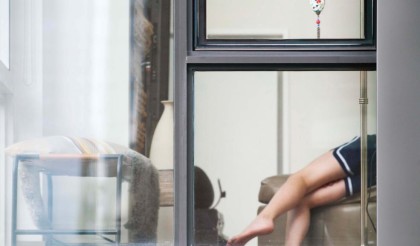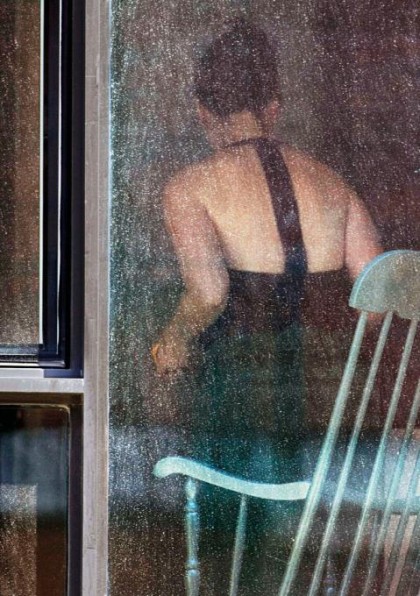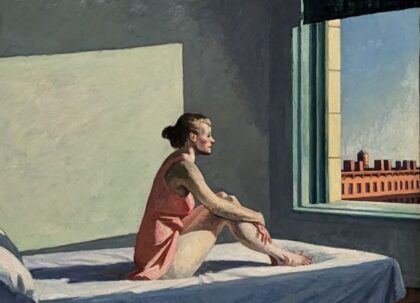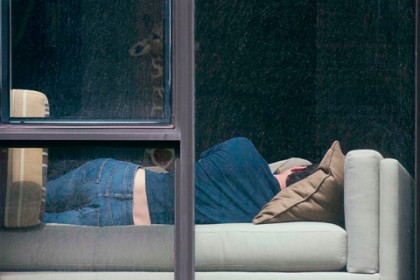Giving new meaning to nosy neighbor
Shame this show is in Santa Monica, since I would have loved to see these photos in person. They were taken by fine art photographer and Tribecan Arne Svenson in 2012 and first shown here in 2013. The series began with Svenson was gifted a telephoto lens and as soon as he set it up, realized the evocative images that he could make by aiming at the building out his window.
“Through the death of a birding friend I obtained his telephoto lens,” Svenson wrote on his website. “Having no interest in birds, I turned to the residents of a glass-walled apartment building across the street from my NYC studio. The Neighbors don’t know they are being photographed; I carefully shoot from the shadows of my home into theirs. I am not unlike the birder, quietly waiting for hours, watching for the flutter of a hand or the movement of a curtain as an indication that there is life within.”
Some of you may remember the bruhaha that ensued: one of the subjects sued in 2013; the case was decided in Svenson’s favor. The plaintiffs filed an appeal, which was again settled in Svenson’s favor. From The Times story on the Santa Monica show: “The appellate judge found that while New York State law prohibits the unauthorized use of a person’s likeness for advertising or commerce, an exception is made for art. At least legally, Svenson’s photographs qualified as art.”
“Defending myself against these charges was one of the greatest challenges of my life,” Svenson writes on his website, “but given censorship as the alternative, I had no choice.”
The images are so beautiful, and since I managed to get to the Hopper show at the Whitney yesterday — the last chance (that also included the BEST celebrity sighting: Annie Leibovitz) — the parallels are obvious.
More from Svenson’s website from this original story: “For my subjects there is no question of privacy; they are performing behind a transparent scrim on a stage of their own creation with the curtain raised high.”
New Yorkers place imaginary walls where our windows are, telling ourselves at some deep level that we can see out but people can’t see in—or perhaps that even though we know they can see in, we persuade ourselves they don’t watch, and, by extension, that they aren’t using telephoto lenses to take photos of us. On the other hand, I could argue that people who live in glass houses shouldn’t have high expectations when it comes to privacy.




















Why promote this? It’s completely creepy. This “exhibit” definitely seems at least rude, and in my “view”, unethical. There is a tacit social norm, a line of privacy that applies, that one would not photograph into someone’s home life without consent, even if a window has no curtains or blinds. Even worse is then to publicize the photos (and presumably profit from them).
So there is definitely a “question of privacy”. And I doubt most of the residents see themselves as “performing”. I bet most, if not all, are probably un-self-consciously living their lives and under the implicit norm I mentioned above, that no one is creepily spying on them. If they thought someone is spying on them in this manner, I expect many of them would buy curtains…after they call the police.
Marcus, there is a reason that despite two separate lawsuits, judges ruled in favor of the artist. Having just scene the show in Santa Monica at James Danzinger, I applaud Pam and Tribeca Citizen for promoting the show – it is no more voyeuristic than the Hopper paintings recently on view at the Whitney of individuals in their apartments, offices, restaurants. Further to the point, there is a dedicated section titled “The Window” which includes a series of works in this vein:
“Hopper spent hours strolling New York’s sidewalks, riding its elevated trains, patronizing its eating establishments, and attending the theater, always on the lookout for new subjects. He was particularly drawn to the fluid boundaries between public and private space in a city where all aspects of everyday life—from goods in a storefront display to unguarded moments in a café—are equally exposed. The window became one of Hopper’s most enduring symbols, and he exploited its potential to depict the exterior and interior of a building simultaneously, a viewing experience he described as a “common visual sensation.” Is there any reason that one medium is “completely creepy” and breaks “a tacit social norm” when the other is one of the most positively reviewed Whitney shows?
https://whitney.org/exhibitions/edward-hopper-new-york?section=2&subsection=1#exhibition-artworks
In fact, Svenson’s photographs obscure the faces, and are often more focused (both in composition and in actual use of “focus”) on the window panes than the individual. In many photographs, dirt and rain on the window panes are more in focus than the inhabitants on the other side.
Throughout my life in NYC, people have consistently criticized and lambasted exhibits, plays, operas etc they have not scene first-hand (Mapplehorpe among others) – to me that is grossly more unethical” than anything either Hopper or Svenson have done. I am proud to have had both men as fellow New Yorkers and neighbors!
@danzingergalleries
Thank you for the thoughtful comment.
My thoughts on that: I don’t know how Hopper worked, so I cannot speak to that. Maybe his methods are such that I would consider them unethical as well.
I still judge this artist’s modus operandi as invasive and objectionable. There’s no need to see the exhibit to make that judgement. It is not an aesthetic judgment (although I think it’s also possible to form a reasonable aesthetic judgement of the work from the reproductions available online, without seeing it in person; many of us have only that kind of access to the world’s artwork if one cannot afford to or have time to travel to see it all) regarding the beauty or formal qualities of the work etc. It’s about how the work was produced, and an evaluation of that process does not require even seeing the work. Whether work was produced under unethical conditions is a separate matter from judging the aesthetic quality of the resulting product, just as a beautiful object may be produced under unethical or exploitative labor conditions. So the ethical dimension is a different axis of judgement from the aesthetic dimension.